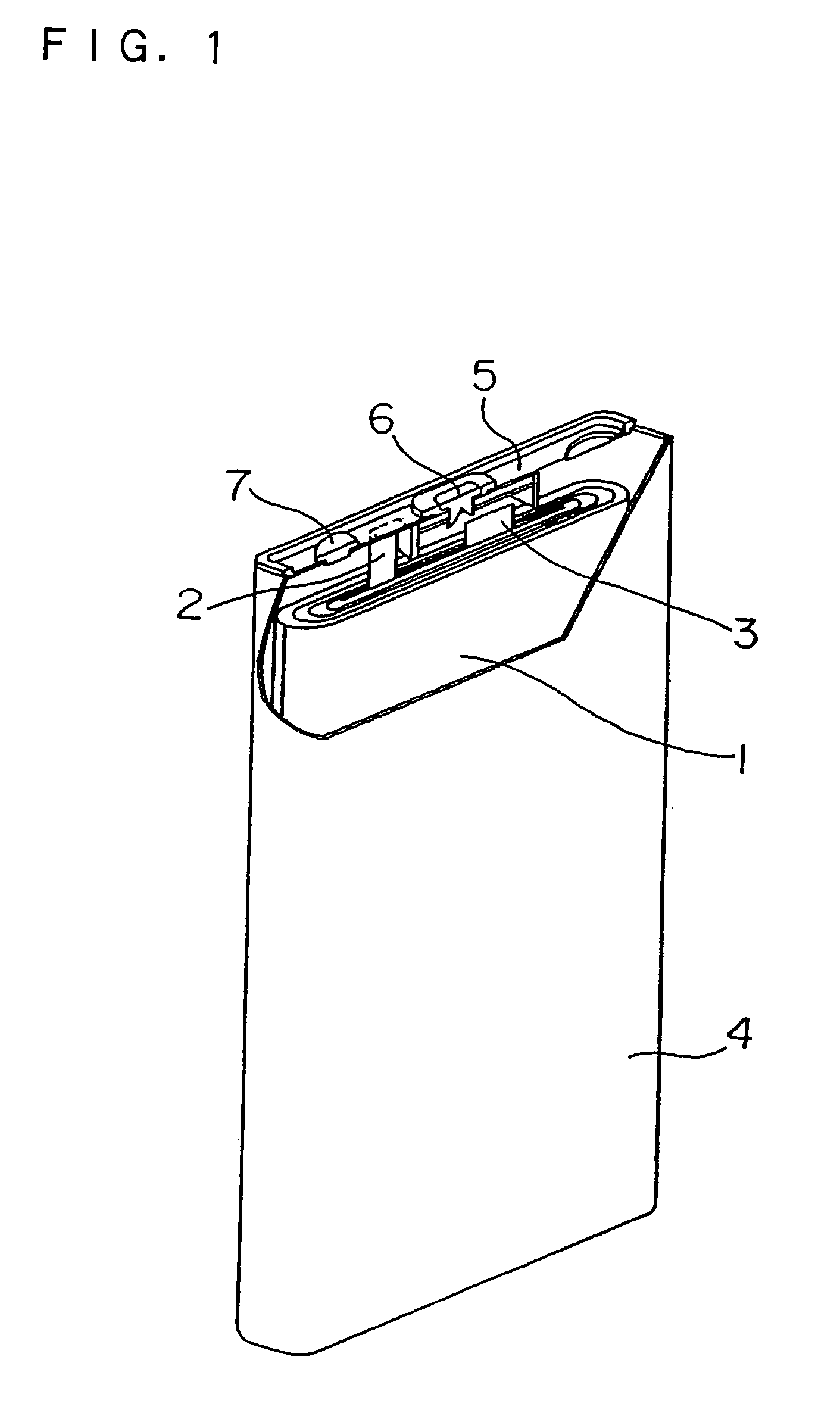On the other hand, the artificial graphite particles of items (II) and (III) are currently not capable of showing reversible capacity close to the theoretical capacity of graphite (poor in reversible capacity as compared with the
natural graphite).
Therefore, in the step of rolling the coated negative
electrode material mixture layer with a roller or the like, problems are apt to occur, e.g., the mixture layer cannot be rolled down to a predetermined thickness, and the falling or peeling of the mixture layer off the core material becomes manifest.
Such problems often result from the kind of graphite particles used as the negative electrode active material.
In light of the inventors' empirical rule, the special artificial graphite particles of item (III) derived from
mesophase carbon are liable to cause the former problem, i.e., the negative
electrode material mixture layer cannot be rolled in
high density.
Further, the artificial graphite particles of item (II) derived from
coke and the like are apt to cause the latter problem of falling or peeling of the mixture layer off the core material.
The
amorphous carbon having no layer structure causes less electrostatic repulsion between particles (interaction between π electrons), which is a phenomenon unique to the layer structure of graphite, and hence is poor in slippage.
Therefore, if such materials are used as the negative electrode active material, the problem is apt to occur, i.e., the resulting negative
electrode material mixture layer cannot be rolled in
high density.
In many cases, it is difficult to obtain particles having a high
bulk density (or a tap density) or a small specific surface area.
This is considered to be a cause of the peeling and falling of the mixture layer while rolling the mixture layer in
high density.
That is, the particles are crushed or collapsed through the rolling of the mixture layer in high density because of the bulkiness of the particles.
Therefore, the
binding state between the core material and the particles or between the particle and particle cannot be well maintained.
Therefore, the rolling of the mixture layer in as high density as over 1.6 g / cm3 is relatively easy and problems accompanying the production are hard to arise.
HEI 11-263612, it is very difficult to shape the whole particles into almost complete spheres even if treatment is given to convert the flake-like particles into massive (spherical) ones.
As a result, characteristic problems may occur, for example: (1) the
edge surface of the
graphite particle through which Li ions are intercalated and deintercalated is hard to
expose to the
electrolyte, which decreases the diffusibility of the Li ions and deteriorates a
high rate discharge characteristic; and (2) expansion and contraction in the c-axis direction of the graphite particles during
charge and discharge are apt to be reflected as the change in thickness of the mixture layer (the degree of expansion and contraction of the electrode is great).
Thus, in the step of rolling the mixture layer in high density, the
natural graphite particles are oriented (i.e., graphite
crystal forming the particles is oriented) and the electrode performance is deteriorated.
With the thus obtained artificial graphite particles, the problem of falling and peeling of the mixture layer is apt to occur.
As a result, the
electrolyte does not permeate sufficiently into the inside of the negative electrode mixture layer rolled in high density, which deteriorates a
high rate charge / discharge characteristic and a discharge characteristic at low temperature.
This problem has not been caused in a conventional battery containing the
electrolyte in a relatively large amount.
Even so, the lithium rechargeable battery designed to have
high energy density has another problem, i.e., the reduction in capacity through the charge / discharge cycles is caused greater than in the conventional battery.
Further, a product generated through the electrolyte
decomposition is deposited as a membrane on the negative electrode surface, which decreases the charge /
discharge efficiency of the negative electrode.
In addition, regarding the high
energy density lithium rechargeable battery of the latest-type formed by winding a positive electrode, a negative electrode and a separator into an electrode group in the form of an almost rectangular column or a
elliptic cylinder, sealing the electrode group in a prismatic
metal case or an
aluminum foil / resin film laminate case and pouring therein a non-
aqueous electrolyte, the battery case is generally low in strength.
These factors conspire to drastically reduce a cycle life characteristic of the battery.
Therefore, it is unfavorable in view of giving high capacity and stability to the battery.
However, as long as specific starting materials (
coke,
tar and
pitch in the case of the above-described publication) are used, there is a limitation in reducing the specific surface area of the particles.
That is, the graphite particles have another
disadvantage that the negative electrode material mixture layer easily falls off the core material while being rolled into a high density electrode, and hence are susceptible to improvement also in this point.
 Login to View More
Login to View More  Login to View More
Login to View More 

